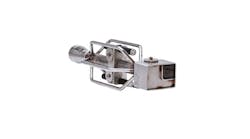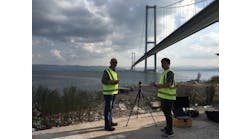The Hale Boggs Bridge in Luling, La., built in the early 1980s, was one of the first in a wave of new cable-stayed bridges opened in the U.S. over the past 25 years. In 2002, after maintenance records and an initial investigation showed some flaws in the stay-cable corrosion protection system, the Louisiana Department of Transportation and Development (LaDOTD) engaged CTLGroup to develop and verify a nondestructive technique with which to evaluate the condition of the cables.
Prompted by and as a result of that work, an inch-by-inch inspection of the stay-cable sheathing was recently completed, and CTLGroup and Bridge Engineering Solutions are currently preparing a comprehensive rehabilitation plan that the state of Louisiana can implement to extend the bridge’s service life and help ensure public safety.
The key to the inspection’s success was a custom-designed and -fabricated inspection vehicle that rode along the cables without damaging them. This traveling buggy system improved safety, saved time and allowed for a more thorough inspection process.
Damaged and corroded
The Hale Boggs Bridge is a twin-pylon cable-stayed bridge with a main span of 1,222 ft and side spans of 755 ft and 768 ft. The bridge carries four lanes of I-310 traffic over the Mississippi River.
The stay cables are arranged along the east and west fascias of the bridge. They are anchored into steel-cross girders at the deck level and into the pylon legs at the main piers. Cables are grouped into a semi-fanned pattern, with 24 sets of cables and a total of 72 cables. The original corrosion-protection system consists of grout-filled high-density polyethelene (HDPE) sheathing pipes surrounding the stay cables. The HDPE sheathing is covered with UV protection tape. Construction records and earlier inspections reported damage to this protective sheathing during grouting, including splitting and cracking of the PE cover pipes and blowout damage of grout ports on several cables.
At one location, an original epoxy repair was found to have deteriorated, resulting in rupture of the protective tape and filler grout and exposure and corrosion of steel wires. Investigators suspected that such deterioration also was in progress at other damaged and repaired locations and that other steel wires would likely be exposed to the environment and moisture in the future.
During a limited dissection of one section of sheathing pipe conducted earlier, investigators noted a split—hidden by the protective tape—that had not been repaired. This discovery argued for the development of a nondestructive testing (NDT) technique that would allow for identification of other such hidden areas of damage on the cables.
Coming up with a plan
In developing the inspection plan, the types of defects previously noted or suspected to occur were taken into account:
- Unfilled splits in sheathing;
- Epoxy-filled splits in sheathing;
- Damage to UV protection tape; and
- Grout voids or damage.
Also considered was a range of NDT techniques capable of detecting flaws in materials and assemblies. Techniques such as acoustic, radiography and magnetic flux leakage detection have been used experimentally to detect damage to main tension elements and grout voids.
It was believed that radiography, thermography and acoustic methods also might be capable of detecting flaws in the PE cover pipe. To verify the applicability of these techniques to the problem at hand, they were tested in the laboratory before they were tried on the actual bridge site.
Mock-ups of stay cables were built using materials and configurations similar to those of the Luling bridge. Flaws were intentionally inflicted in the form of splits—with and without epoxy repair—on the PE covers prior to wrapping them with protective tape. The various NDT techniques were then tried to verify their applicability and accuracy.
Each of the methods offered advantages and disadvantages in terms of effectiveness, efficiency, adaptability to field conditions and cost. After evaluating the various options, LaDOTD chose to proceed with a large-scale condition assessment that included a full hands-on inspection.
One of the main challenges of the condition assessment was safe access for inspectors along the length of the cables. It was quickly determined that the best approach would be to use a manned inspection vehicle that crawls along the stay cables. Although the design and fabrication of the inspection vehicle required considerable time and cost, this approach offered some significant benefits, such as:
- Thoroughness—Inspectors were able to cover every inch of the cable sheathing and combine visual inspection, hammer sounding and thermography to get the clearest possible picture of its condition.
- Improved comfort and safety—Compared with the alternative of rope rigging and bosun’s chairs, the inspection hoist allowed investigators to concentrate more fully on the work at hand and worry less about personal safety. Additionally, inspectors were able to work comfortably in winds up to 20 mph, limiting the time lost to bad weather.
- Reusability—LaDOTD intends to keep the buggy and use it for future inspection, maintenance and repairs to the Luling bridge.
- Minimal environmental impact—The inspection could be carried out quickly and with minimal disruption of traffic on the bridge. Traffic restrictions were limited to shoulder closures, thus limiting additional congestion and auto exhaust emissions. The methods used also allowed inspections to be conducted thoroughly without removing, disposing of and replacing miles of UV protection tape that enclose the PE cover pipe.
Hoisting vehicle
Lisbon Hoist designed the inspection vehicle based on input from LaDOTD, CTLGroup and CTLGroup’s rigging subcontractor, D. Peryea and Co. LLC. The buggy had to be capable of carrying two inspectors and equipment while traveling at a rate of about 50 ft per minute. It also had to provide good access to multiple cables in a cable group; be simple to install, operate and move; and meet all OSHA safety requirements.
Upon approval of design drawings, Lisbon Hoist fabricated the vehicle in its Lisbon, Ohio, plant early in 2006. The vehicle basket was fabricated from aluminum to reduce weight and incorporated step platforms and extension railings to allow access to the upper cable in a cable group. The basket was attached to the lower cable of each group by a pair of rollers. Lift was provided by a hoist wire rope installed parallel to the cable and a standard wire-rope hoist attached to and operated from the basket. Safety brakes were provided both on the hoist and upper roller. Bridge Inspection Systems installed and tested the rigging and buggy on the site and provided rigging and safety support during the inspection.
The inspection process
The inspection began in April 2006 and was expected to take 12 weeks to complete. Two inspectors rode in the hoist, observing and hammer-sounding the cable cover pipe and UV protection tape to locate damage. Infrared thermography was used selectively to detect open splits in the PE cover pipes. As they went along, the inspection teams carefully recorded their observations. The teams were able to cover about 700 ft of cable during a typical 10-hour shift, inspecting over 51?2 miles of cable. Although they were working at heights ranging from 150 to over 400 ft above the river, the inspection vehicle allowed them to perform the inspection safely and efficiently. Thanks largely to good weather, the inspection was completed in only nine weeks.
The inspection records give an excellent quantitative assessment of the stay cables’ condition and will allow for development of a comprehensive rehabilitation plan for the bridge. Gathering this information will not only help the state of Louisiana allocate the needed resources to prolong the service life of the Hale Boggs Bridge, but it also may help bridge authorities elsewhere anticipate deterioration and maintenance needs as other cable-stayed bridges age.

